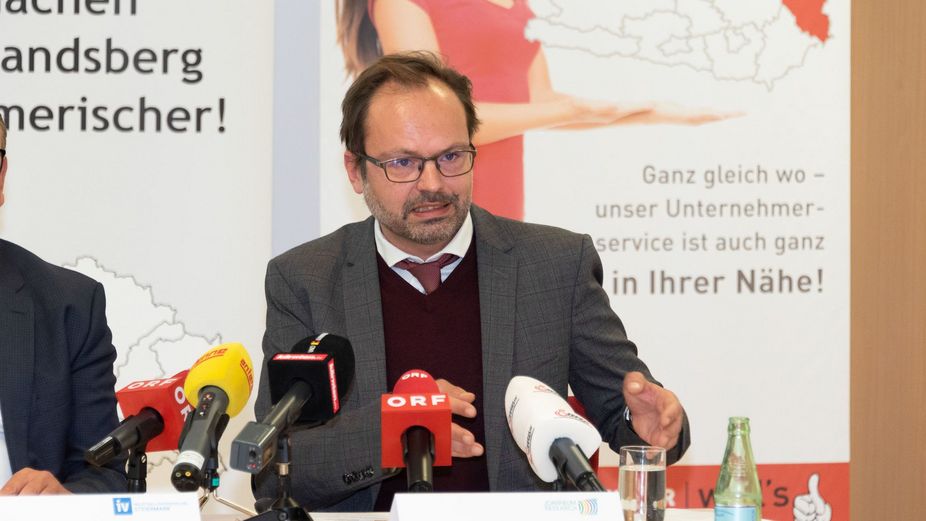New metropolitan region
The current Part II of this major South Austria location study project focuses on the districts of Deutschlandsberg and Wolfsberg , which are directly affected by the Koralm railway project, and shows for the first time the small-scale regional economic effects of a major, cross-regional infrastructure project.
The effects that will result from the changes in accessibility are considerable and can hardly be underestimated: A new urban agglomeration, a new metropolitan region will emerge - with international visibility and appeal. Carinthia and Styria grow together. This will result in enormous opportunities that must be actively utilised.
One of the most important infrastructure projects in Europe
In addition, the Koralm railway is also part of the new southern line and connects Austria's north and south in a modern and sustainable way. As part of the Baltic-Adriatic Corridor, the southern line is one of the most important infrastructure projects in Europe. It connects the most important seaports with the up-and-coming industrial areas in Central Europe and is considered one of the main arteries of our economy.
The survey in detail:
A new urban agglomeration Graz - Klagenfurt is emerging
The Koralm railway will create an agglomeration. The "core area" - the (future) urban agglomeration Graz-Klagenfurt - comprises those municipalities that can reach one of the railway stations along the route in 40 minutes on average. The (extended) catchment area stretches from southern Upper Styria to Villach. The extended Graz-Klagenfurt urban agglomeration will have a total of around 1.1 million inhabitants and half a million employees, with over 130,000 working in the manufacturing sector.
Die Peripherie rückt ins Zentrum mit zwei industriell-gewerblichen Bezirken im Kern
From 2026, the districts of Wolfsberg and Deutschlandsberg will be at the centre of this new urban agglomeration and within daily commuting distance of Klagenfurt and Graz. Both the district of Deutschlandsberg and the district of Wolfsberg have experienced enormously positive development over the past two decades. Both districts are characterised by industry and commerce and have not only defied the de-industrialisation trends that can be observed in many parts of Europe, but have counteracted them.
Centre-periphery contrast is being reduced
Due to the complementary structure of the two districts, the Koralm railway will create a WIN-WIN situation that will also affect the other districts involved. A better connection of peripheral regions to urban agglomerations generally has a double effect: (1) the periphery is connected to the urban infrastructure (access to jobs, an urban ecosystem, etc.) and (2) the agglomeration pressure can be alleviated (the catchment area expands - new (affordable) space is opened up).
Labour market becomes more dynamic
For employees, the new southern railway expands the search radius. It will be possible for them to take up new jobs in regions that are currently not within daily commuting distance. The opportunities to find suitable employment will increase significantly in both federal states. Commuter flows between the individual regions along the Koralm railway will increase significantly, with the effects being highest for travel times of up to 40-50 minutes. The estimated average increase in commuter flows is just under 35 %.
Infrastructure against emigration: breaking the demographic trend
The Koralm railway project offers a great opportunity to break the negative demographic trend in the region of southern Austria. A quantitative model estimate of the direct and indirect effects that the opening of the Koralm railway will have on the Graz-Klagenfurt urban agglomeration, but above all on the respective regions, the Styrian and Carinthian municipalities, shows a significant positive correlation between infrastructure expansion and population development. The presence of a railway station is associated with 2.86 percentage points higher population growth. Access to a railway station increases the expected population growth by just under 2%.
An internationally visible region: the second largest conurbation in Austria
The new Graz-Klagenfurt conurbation will be the second largest conurbation in Austria after Vienna and an important conurbation even on an international scale. In the German-speaking area, only Berlin, Vienna, Munich, Hamburg and Cologne have more than 1 million inhabitants. On the basis of a joint marketing strategy, the new agglomeration should also develop economic appeal beyond Austria's borders.
Statements
- Peter Kaiser, Governor of Carinthia: "As the responsible parties in Carinthia and Styria, we have recognised the enormous future potential for our two federal states that lies in joint cooperation and in a joint Southern Economic Area - Carinthia and Styria: the star of the South! We are already in the process of realising this potential through collaborations such as with Joanneum Research, Silicon Austria Labs, the Digital Innovation Hub South, the Green Tech Cluster and the Silicon Alps Cluster. As an economic and employment driver, the Koralm Railway will become a cooperation and innovation accelerator. By further bundling and coordinating our strengths, we have the opportunity to be successful together in European and international competition and to become visible and attractive both for companies and for urgently needed labour."
- Christopher Drexler, Governor of Styria: "With the Koralm railway, a project of the century is on the home straight. It will be one of the most important transport axes not only for Styria and Carinthia, but for the whole of Austria. I am particularly pleased that this new study shows so many positive effects, especially for the regions in the Styrian-Carinthian border area. It can and should also serve as a basis and guide for regional development so that we can maximise the many potentials. We are taking a further step in the traditionally good co-operation between Styria and Carinthia. Our Styrian-Carinthian axis will become even stronger - creating growth, jobs and an even better quality of life."
- Manfred Kainz, Regional Head of WKO Deutschlandsberg: "The opportunities and development potential of the Koralm railway are enormous. Emperor Franz Josef already wanted a fast railway connection to Carinthia. Clever minds and the will to co-operate in the region have led to an early start being made on implementing the economic framework conditions (Laßnitztal Entwicklungs GmbH, land purchases, etc.). Both Deutschlandsberg and Wolfsberg will experience a huge upswing and a massive influx after the completion of the railway line. I am convinced of this. The task now is to develop a joint, cross-province perspective beyond the district borders."
- Gerhard Oswald, District Chairman WK Wolfsberg: "Wolfsberg and Deutschlandsberg have already begun to forge the cornerstones of an initial joint regional policy agenda and strategy at district level. Because the faster and better coordinated we work, the better the development in both districts will be and the more immediate the positive effect of this project of the century will be. The task now is to utilise all synergy potential. Then all economic sectors on both sides of the Koralm will benefit, from industry and commerce to modern services and tourism."
- Gerold Grill, Managing Director SVI Austria GmbH: "The Koralm Tunnel opens up many new opportunities and for us as an industry it is very clear that both sides - Carinthia and Styria - will benefit enormously from this new connection. The prerequisite is good preparation, which extends into the most diverse areas and far beyond the infrastructure. This will not only create a viable transport corridor, including a connection to Vienna via the Semmering Tunnel, but also a new regional understanding in the south of Austria."
- Horst Johann Jöbstl, MsC, IV Carinthia: "I see great opportunities for the development of the industrial location in the region. The Wolfsberg district is already the most industrialised in Carinthia, with 41.6 per cent of employment in the manufacturing sector. However, it also suffers disproportionately from the high number of vacancies that are difficult to fill. With the Koralm railway, the district is now moving into the centre of the central area between Graz and Klagenfurt/Villach and will be much easier to reach. The university and research locations in the metropolises are now within easy, environmentally friendly commuting distance. This means that the numerous high-tech companies in our region are suddenly an option. However, in order to attract young urban immigrants, we need affordable starter flats and well-functioning public transport with the Lavanttal central railway station away from the efficient main route."
- Eric Kirschner, JOANNEUM RESEARCH Forschungsgesellschaft: "The Koralm Railway is the largest socio-economic project in Austria since the construction of the Semmering Railway. The present analysis shows that the effects resulting from the change in accessibility are significantly positive, both in terms of economic dynamism and competitiveness, i.e. economic growth and employment, as well as in terms of demographic development. However, it should be noted that this does not happen automatically. The framework conditions must be designed accordingly in advance and synergies must be utilised proactively, both regionally and interregionally."
- Ewald Verhounig, Institute for Economic and Location Development:"In order to sustainably utilise the enormous regional economic opportunities that the Koralm Railway brings with it, a coordinated, interregional strategic management of the entire axis with the districts of Deutschlandsberg and Wolfsberg in focus is required. The first regional policy starting points are securing and expanding the complementary transport infrastructure and business infrastructure as well as implementing interregional cooperation in the area of education and training. In addition, the international positioning of southern Austria as an attractive place to work and live must be actively promoted."



